Design Awards 2015: best of the rest
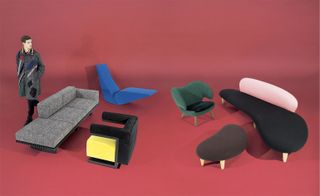
Best Alliance
Fabrics and furnishing accessories, by Raf Simons and Kvadrat
Raf Simons' polymath credentials are well established but nowhere better illustrated than in his ongoing collaborations with the textile specialist Kvadrat. Simons first turned to Kvadrat while still design chief at Jil Sander, cutting and shaping its textiles into catwalk-friendly forms. Kvadrat in turn asked the Belgian designer to create a collection of furniture fabrics. Launched earlier this year, the collection includes sculptural fabrics in mohair, polyester, cashmere and wool, as well as home accessories such as throws and cushions. And as a confirmation of the fabrics' versatility, swatches of Simons' Kvadrat effort were used in the A/W14 collection, created in collaboration with US artist Sterling Ruby.
Pictured: Model wears clothing from the Raf Simons/Sterling Ruby A/W14 collection. Also pictured is Simons' pick of classic design pieces, upholstered in his fabric collection for Kvadrat. From left, 'Refolo' sofa, by Charlotte Perriand, for Cassina, upholstered in 'Sonar 2'; 'F51' chair, by Walter Gropius, for Tecta, upholstered in 'Astor' (back and armrests) and 'Harald 2' (seat); 'Bird' chaise longue, by Tom Dixon, for Cappellini, upholstered in 'Pilot'; 'Pelican' chair, by Finn Juhl, for Onecollection, upholstered in 'Pilot' (body) and 'Haakon 2' (cushion); and 'Freeform' sofa and ottoman, by Isamu Noguchi, for Vitra, upholstered in 'Vidar 2'
Writer: Rosa Bertoli
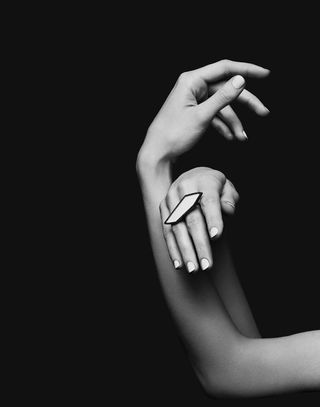
Best Jewellery
'Signature’ ring, by Monique Péan
When it comes to sourcing unique raw materials, jeweller Monique Péan always digs deep. In fact, the New Yorker’s procurement process is akin to an archaeological expedition, given that her petrified creations star an avant-garde offering of fossilised woolly mammoth and walrus ivory, along with agatised dinosaur bone. Since 2006, the former Goldman Sachs analyst has been working with indigenous Alaskans in the Arctic Circle to gather ivory fossils, which are the result of 10,000 years of mineralisation. When ice in this region melts and shifts, the fossils rise to the surface and are collected by Péan’s community of fossickers. The designer sets these one-of-a-kind organic forms with 18ct recycled gold and ethically sourced or repurposed diamonds.
Pictured: Fossilised woolly mammoth ivory and black diamond geometric 'Signature' ring in 18ct recycled oxidised white gold, £8,100, by Monique Péan, from Dover Street Market
Fashion: Zoë Sinclair; Writer: Katrina Israel
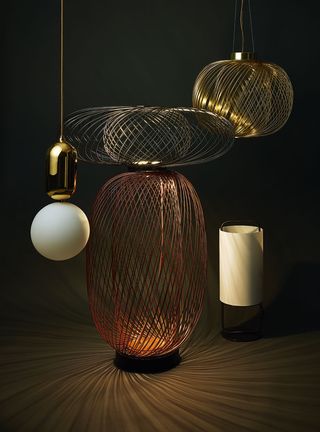
Best New Brand
Lighting company Parachilna
The name of this Barcelona-based lighting company was inspired by a visit to Parachilna, a remote settlement north of Adelaide. We can't see the link between high-end lights and the Australian outback either, but at least the brand's intentions are clear. 'Parachilna was born from our love of luxury,' says its team. 'For us, luxury is about the quality of the materials and the craftsmanship that creates it.' Stephen Burks' 'Anwar' lamps, made from welded steel rods, have been followed by collections by Jaime Hayon and Jordi Veciana using hand-blown glass, ceramic and metal. We think it's a bright start.
From left: 'Aballs T Me' pendant, £830, by Jaime Hayon; combined floorlamp comprising 'Anwar P 90' base and 'Anwar 30' top, £4,581; 'Anwar T 45' pendant, £2,082, both by Stephen Burks; 'Alistair M' table lamp, £1,017; by Jordi Veciana, all for Parachilna
Interiors: Maria Sobrino; Writer: Christopher Stocks
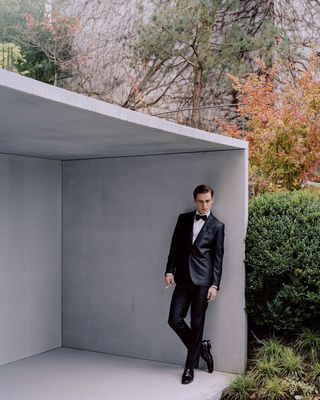
Best Smoking
We're well suited for a postprandial puff in this dedicated pavilion
Having a dedicated space for each favourite activity is a hallmark of luxury - think a library, a games room, a spa. Commissioned by a private client for a Zurich townhouse, this smoking pavilion is a worthy addition. Designed by London-based architect Gianni Botsford, it allows the owners to admire the garden while enjoying a postprandial puf and without affecting other residents. Botsford was drafted in by landscape architect Todd Longstaffe-Gowan. 'Our idea was to create a simple structure possessing a richness and complexity in its materiality that would develop relationships with the surroundings,' Botsford says. The first self-supporting translucent concrete building made from engineered precast panels, it seems solid yet light. Altogether as smooth and striking as the Philipp Plein suit we chose to spark up in.
Pictured: Suit, €1,075, by Philipp Plein. Shirt, £125; bow tie, £65, both by Hardy Amies. Shoes, £550, by Jimmy Choo. Romeo y Julieta Belicosos cigar, £20, from 1A St James Street Tobacconists
Writer: Ellie Stathaki; Fashion: Mathew Stevenson-Wright

Best Coffee and Cake
Bringing rigour to our sugar rush
There's a new order to our afternoon coffee break. Design studio Lucy.D collaborated with Vienna's historic Café Landtmann to create a clean, contemporary take on fancy cakes, using embossing and airbrushing techniques. Portuguese porcelain brand Vista Alegre's 'Orquestra' tableware by design duo David/Nicolas serves up a symphony of geometric patterns. And the limited-edition, stackable 'Sucabaruca' cofee set, conceived by Luca Nichetto and Lera Moiseeva for Toronto gallery Mjölk, a tribute to Jean-Paul Goude, brings a pop of colour to proceedings.
Best cake: 'Landtmann Kollektion' design cake collection, from €10 to €110, by Lucy.D, for Landtmann's Feine Patisserie. 'Orquestra' bread and butter plate, £11; square solar plate, £19; Large oval platter, £45; dinner plate, £15, all by David Raffoul and Nicolas Moussalem, for Vista Alegre. 'Tortensschaufel' cake slice, €560, by Josef Hoffmann, for Wiener Silber Manufactur. Best coffee: 'Sucabaruca Memphis Pop' coffee service, with pot, funnel and three cups, £495, by Luca Nichetto and Lera Moiseeva, for Mjölk. 'Sucabaruca' marble tray, £495, by Mjölk
Food: Ulrike Dorner; Writer: Sujata Burman

Best Space Race
Design goes out of this world
Space may be the final frontier, but a group of adventurous designers has been boldly going where few designers have gone before, with some rather stellar results. Germany's Jan Kath started the space race by taking images from the Hubble space telescope and turning them into hand-knotted rugs (why did no one think of that before?), while his fellow countrywoman Elisa Strozyk has been turning her tables to give them an uncanny resemblance to pictures of Earth from space. Not to be outdone, Diesel Living has collaborated with Seletti on a dinner service called 'Cosmic Diner', with designs based on the solar system - a planetary theme shared by Milan-based Dimore Studio's cast-resin 'Lampada 061'. And for Minotti, Rodolfo Dordoni all but eclipses the competition with a circular metal tabletop that orbits 360 degrees over its elliptical ebony base. We have blast-off!
Clockwise from top left, tall ceramic table, £3,450; small ceramic table, £3,000, both by Elisa Strozyk, from Mint. 'Lamp 061', price on request, by Dimore Studio. 'Cosmic Diner' plates, from £19, by Diesel Living, for Seletti. 'Benson' coffee table, £3,040, by Rodolfo Dordoni, for Minotti. 'Spacecrafted/Space 3' rug, £2,380 per sq m or £17,850 as seen, by Jan Kath
Interiors: Matthew Morris; Writer: Christopher Stocks
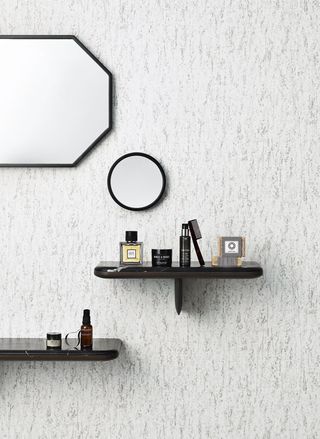
Best For Men Only
Our favourite launches to tame whiskery faces
We can accept a unisex scent or two, and skincare technology works whatever the gender, but with men's faces having gone in an unwaveringly bristly direction of late, there's less room for product sharing. We've gathered the best recent launches to tame and tidy, from a sweetly scented beard oil from the studiedly stubbly Tom Ford to a fine new fragrance from Guerlain, its bitter almond note balanced with unmistakably masculine undertones of cedar wood, patchouli, vetiver, leather and bergamot. As for the perfect male groom room, ours shapes up nicely with Doshi Levien's mix-and-match geometric mirrors for Hay, and Jean Louis Iratzoki's elegant shelves for Retegui, our pick from the Basque marble company's first foray into furnishings.
Pictured: Top shelf, L'Homme Idéal, £48, by Guerlain. Volcanic as wax, £20, by Windle & Moodie. Conditioning beard oil, £40; beard comb, £28, both by Tom Ford. Tea soaps, £4 each, by London Fields
Wallpaper* Newsletter
Receive our daily digest of inspiration, escapism and design stories from around the world direct to your inbox
Writer: Emma Moore
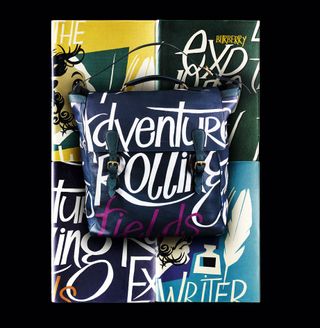
Best Book Bag
Travel satchel and sketchbooks, by Christopher Bailey, for Burberry Prorsum
For his S/S15 menswear show for Burberry Prorsum, Christopher Bailey referenced the literary spirit of 20th-century English writer and adventurer Bruce Chatwin. Illustrated graphics, scribbled across wanderers' satchels, trenches and leather-bound sketchbooks, were inspired by vintage travel-book typography and watercolours uncovered in flea markets. Classic English hardback covers similarly frame travellers' scarves and tees, featuring titles such as British Birds of Prey and The History of English Tailoring. The designs were hand-painted at Burberry's London studio and printed for Bailey's spring offering in Italy. Wherever your travels take you, these bookish pieces should give you something to write home about.
Pictured: Bearing prints inspired by vintage travel books, travel satchel, £1,695; leather sketchbooks, £695 each, all by Burberry Prorsum
Writer: Katrina Israel
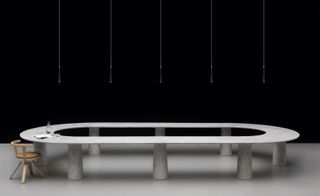
Best Boardroom
A racetrack-style table shows thoroughbred form, while a birch swivel chair has us in a spin
Executive suites should be dressed to impress, but are all too often kitted out in the decorative equivalent of a downmarket suit with a low wool content. So Jasper Morrison's 'Arena' table for Marsotto Edizioni was a welcome launch last year. Showcasing the company's winning way with Carrara marble, the modular system features slim worktops supported by sturdy tapered columns, and can be configured to fit boardrooms from the modest to the megalomaniac. We've teamed it with Artek's 'Rival' chair, Konstantin Grcic's first design for the brand. With laminated birch arms and back, and solid birch legs, it has a classic Finnish feel, but Grcic, our joint Designer of the Year, has added a touch of playfulness by hiding a swivel function under the circular seat.
Pictured: 'Arena' modular table system, €43,920, by Jasper Morrison, for Marsotto Edizioni. 'KG001 Rival' chair, €843, by Konstantin Grcic, for Artek. 'Nice Up' suspension lights, €398 each, by Tobias Grau. 'Tela' carafe, €43; tumbler, €11, both Silo Studio, for Hay. 'Drake 7011' pen, £60, by Adam + Harborth Design. For E+M Holzprodukte. Studybooks, £10 for two; cork sketchbook, £8; paper clips, £3.50 for 100, all by Nomess
Interiors: Maria Sobrino; Writer: Christopher Stocks

Best Executive Office
Furnished to make the daily grind refined
Some people may use their office only to work in, but we like to have the option of kicking back after a bit of hard graft. So we were pleased to come across Doshi Levien's 'Almora' armchair and footstool for B&B Italia, with a merino-wool headrest that designer Nipa Doshi describes as like 'seeing the snow-capped Himalayan peaks [while being] wrapped in a soft, warm blanket'. Still, no office would be complete without a desk, and among the niftiest new models is Rodolfo Dordoni's executive furniture system for Poltrona Frau, with a concealed wiring system and oak-and- leather surfaces. Bathe everything in a gentle glow with Joan Gaspar's clever 'Ginger' lamp for Marset, which fuses layers of wood and paper to create an ultra-lightweight shade.
Pictured: ‘Almora’ chair, £6,074; ottoman, £1,439, both by Doshi Levien, for B&B Italia. ‘Jobs’ desk, price on request, by Rodolfo Dordoni, for Poltrona Frau. ‘Ginger’ pendant lamp, £310, by Joan Gaspar, for Marset, from Twentytwentyone. ‘Kinesit’ office chair, from £800, by Lievore Altherr Molina, for Arper. On Desk, 'Stop’ bookends, from £114; ‘Pen’ tray, from £91, both by Philipp Mainzer, for E15, from Viaduct. ‘Portobello’ diary, £180; ‘Kings’ diary, £220, both by Smythson. ‘Haus’ paperweight, £34, by Jan Philip Holler, for E15, from Viaduct. ‘Lapis’ espresso cup and saucer, £75, by L’objet, from Harrods. ‘White Crystal’ fountain pen, £2,550; ‘Black Crystal’ roller pen, £1,990, both by Caran D’Ache, for Lalique
Interiors: Amy Heffernan; Writer: Christopher Stocks
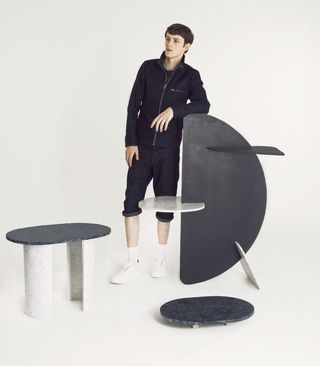
Best Denim
From worn-out jeans to cool new furniture
Denim is proving a surprising ally in the push towards sustainability, with fashion and furniture projects cleverly devising new and environmentally friendly ways of dealing with the material. London-based design pair Matteo Fogale and Laetitia de Allegri launched -Ish, a collection made of Denimite, a marble-like material created from post-industrial denim scrap; another version of the material, called Marblus, is made from scraps of cotton taken from discarded sheets and clothing. Lightweight, mouldable and extremely resistant, they give a new face to recycled materials. Also concerned with denim and the preservation of the environment, G-Star Raw enlisted Pharrell Williams to work on a new collection of sustainable textiles. His designs, developed in collaboration with Aitor Throup acting as creative consultant, transform plastic collected from the ocean into a 'Bionic Yarn' that is used in jackets, jeans and accessories.
Pictured: ‘Side Table 2’, £1,650; Standing Shelves, £1,620; ‘Tray 3’, £420, all part of the -Ish collection, by Matteo Fogale and Laetitia de Allegri. Jacket, £210; jeans, £130; t-Shirt, £50, all by G-Star Raw for The Oceans. Shoes, £90, by Eytys, from Matches Fashion
Fashion: Mathew Stevenson-Wright; Writer: Rosa Bertoli
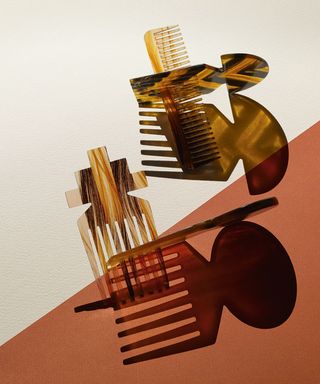
Best Hair Tools
Combs, by Studio Swine, for Pearl Lam Galleries
It's not often the design of a comb piques our interest, but this series of hair tools reeled us in. There's more than simply the elegance of their forms to admire; the material story is equally compelling. The combs are part of a collection called 'Hair Highway', designed by London-based Studio Swine for Pearl Lam Galleries. It's the culmination of a material research project in which the design duo considered the seemingly disparate facts that China is the largest importer of hardwoods and the largest exporter of human hair. They decided to seek some balance, finding a way for China to reduce its reliance on diminishing resources. Their invention is a composite made from Asian hair and resin that mimics the tones of tortoiseshell and the grains of polished horn or exotic hardwoods. The synchronicity of function and material in the combs makes this particular part of the project all the sweeter.
Pictured: Combs, by Studio Swine, for Pearl Lam Galleries, $1,300 each
Writer: Emma Moore
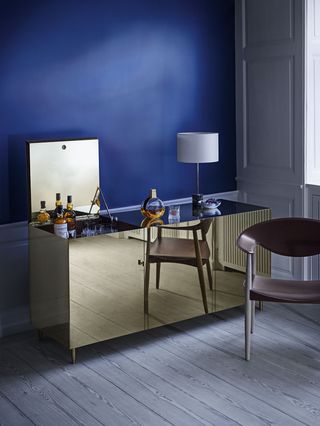
Best Whisky Den
Make ours a large one
The first sight of Ilse Crawford's polished brass and oak cocktail cabinet inspired us to find a snug corner, install it, pull up a chair and create our own whisky den. Our chair is the 'Metropolitan', by Ejner Larsen and Aksel Bender Madsen, recently reissued by Carl Hansen in cocooning oak and leather, while our crystal is a collaboration between J Hill's Standard and Martino Gamper. The most essential ingredient, though, is the Scotch from the cellars of Glenmorangie. Pride 78 is a newly released single malt with marzipan, wood and tobacco notes. Its rareness is celebrated with a Laurence Brabant decanter bottle. The supporting artists are a peaty Caol Ila 30 and a spicy Balvenie. The scene is set.
Pictured: ‘The Brass Cabinet‘, price on request, by Ilse Crawford, from The Apartment. The Balvenie single barrel 25-year-old whisky, £400, from The Whisky Shop. Caol Ila 30, £425, by Master of Malt. Glenmorangie Pride 1978, including Laurence Brabant decanter, Wouter Scheublin display case (not seen) and Idris Khan artwork (not seen), £3,000, from Glenmorangie. ‘Cuttings’ whisky glass, £98, by Martino Gamper, for J Hill’s Standard. Small bowl, price on request, by Bing & Grøndahl, for Royal Copenhagen. Lemon, raspberry, mint and liquorice almonds, DKK46 (€6) for 100g; Chocolate tapas, DKK110 (€15) for 90g, both from Summerbird. ‘Kilo Emperador’ lamp, €1,270, by Kalmar, from The Apartment. ‘Metropolitan’ chair, from £1,972, by Ejner Larsen and Aksel Bender Madsen, for Carl Hansen & Søn
Interiors: Nathalie Schwer; Writer: Emma Moore
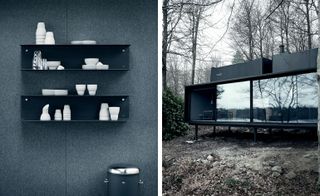
Best Brand Extension
Vipp's new prefab steel shelter is the perfect place to showcase its classic homeware
A prefabricated steel shelter is not the most obvious new design for a company whose signature product is a pedal bin, but there's really nothing to discard in Vipp's latest project. The Danish homeware manufacturer, renowned for its bin designed in 1939 by Holger Nielsen, has now launched the Vipp Shelter, 'a battery-charging station for humans,' as the brand's MD Kasper Egelund affectionately describes it. Egelund worked closely with Vipp chief designer Morten Bo Jensen to create a structure that follows Vipp's adherence to Dieter Rams' motto of 'less but better'. It's all about 'going back to nature with basic functions defining a dense, compact space with a clear aesthetic,' says Jensen. The prefabricated shelter, which can be installed anywhere, is inspired by the design of airplanes, submarines and ferries. The 55 sq m steel-grid structure boasts a large living area and kitchen with a corner fireplace and sliding glass doors, a bathroom and a loft bedroom. It comes equipped with a full range of Vipp products, including the lighting, kitchen accessories and bed linen.
Left: The shelter's kitchen comes furnished with the Danish brand's own products. 'Vipp922' shelves, €249 each; ceramics, from €29 each; glasses, from €19 each; 'Vipp17' bin, €375, all by Vipp. Right: Vipp's prefabricated cabin builds on the brand's expertise in working with galvanised steel
Writer: Rosa Bertoli
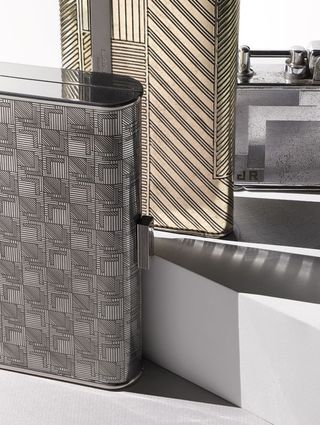
Best Use of Archive
Clutches, by Lancel
Lighting up French maison Lancel's spring offering is a new series of metallic evening accoutrements. The patterns are inspired by an art deco lighter designed by Albert Lancel - son of founders Angèle and Alphonse Lancel - in 1932. The said fame-bearer, which features a working clock face, won the Frenchman a Grand Prix at the 1937 Exposition Internationale des Arts et Techniques dans la Vie Moderne in Paris. After being reacquired recently by the house at auction, the lighter's graphic guilloché print has been hand-stamped onto this season's metallic leather clutch and engraved into a handsome metal minaudière.
Pictured: 'Varenne de Lancel' leather clutch, €450; metal organiser, €1,190, both by Lancel. The brand's 1932 lighter, far right, inspired the patterns
Writer: Katrina Israel
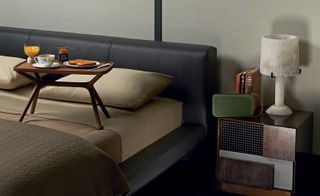
Best Breakfast In Bed
Style and substance make excellent bedfellows
Some beds are made for extended stays. Walter Knoll's 'Jaan' bed by Eoos, part of the manufacturer's first foray beyond seating into sleeping, is one such cocoon. So holing up with Baxter's new night table by Draga & Aurel by our side, CTO Lighting's 'Acropolis' lamp illuminating our reading matter and B&O Play's new Bluetooth speaker providing the sounds, we thought we'd bring to the slumber party a breakfast fit for a king. Served on Mattia Fossati's 'Ics' table is perfectly proportioned toast, made from a wholemeal multi-seed loaf courtesy of new Parisian bakery Liberté, topped with morning-changing Negroni marmalade by Melbourne's newest gin distiller Four Pillars. The juice, cold-pressed by Toronto's Greenhouse Juice Company, blends orange, grapefruit, lemon and liquid cayenne pepper. We've got our finger on the snooze button.
Pictured (from left): ‘Unique’ table, £2,880, by Draga & Qurel, for Baxter. ‘Aacropolis’ lamp, £1,530, by CTO Lighting. ‘A2’ bluetooth speaker, £299, by Cecilie Manz, for B&O play. ‘Jaan’ bed, £4,000, by Eoos, for Walter Knoll. ‘Prairie Buri’ flat sheet, £259; ‘Prairie Buri’ pillowcase, £60; ‘Satin Dune’ fitted sheet, £199; ‘Satin Dune’ flat sheet, £249; ‘Amar’ bedcover, £375, all by Calvin Klein, from Harrods. ‘Ics’ table, £696, by Mattia Fossati, for Porada. ‘No. 192’ cutlery, from £350 for set, by Thomas Feichtner, for Jarosinski & Vaugoin. ‘Carrara’ plate, £29; teacup and saucer, £49, all by Bodo Sperlein, for Dibbern. Bread, from a selection, by Liberté. Breakfast negroni marmalade, A$9 (£5), by Four Pillars Gin. Condiment spoon, £8.50, by Abbeyhorn, from Twentytwentyone. ‘On the Rock’ glass, £65, by Lee Broom. ‘Wake Up’ raw, organic cold-pressed juice, C$8 (£4.50) for 250ml, by Greenhouse Juice Co
Interiors: Amy Heffernan; Writer: Emma Moore
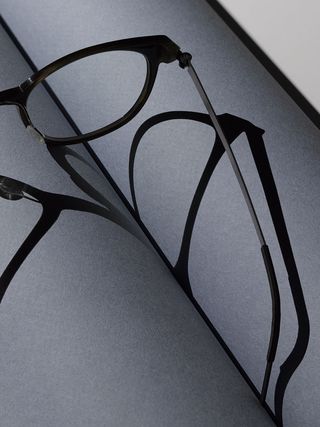
Best Technique
Buffalo horn glasses, by Lindberg
The long and short of sight have been sporting horn-rimmed specs since the 16th century. However, most opticians have long since abandoned actual horn in favour of more easily tamed replica materials. Three years ago, Danish spectacle maker Lindberg, always up for a challenge, took on the task of bending, or rather, unbending genuine horn to its will and minimalist aesthetic. The company uses specially treated laminated strips of buffalo horn, bonded with its secret recipe glue. And, in the latest collection, Lindberg has matched it with a titanium nose bridge, temples and hinges to create specs that offer horn's unique glow and colouration but with unprecedented lightness, sleekness and comfort. Proper horny.
Pictured: glasses, from £720, by Lindberg Horn
Writer: Nick Compton
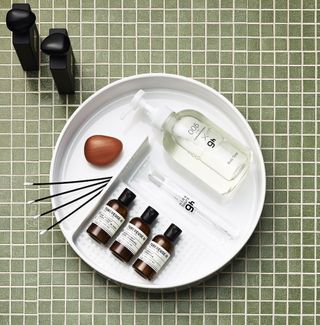
Best Hotel Amenities
Who's awash with style
With lofty standards for our own toiletries, we felt it was time to commend the hotels also getting them right. New favourite is New York Park Hyatt's collaboration with Le Labo, which has created a range in its Tubereuse scent, inspired by the city. Milan's Armani Hotel produces its own offerings: generous-sized bottles are accompanied by an amber soap and black Q-tips. And at Kyoto's Nine Hours capsule hotel, creative director Fumie Shibata ensured the coherent design of amenities in a collaboration with Tamanohada, known for its fig-scented products.
Pictured (from left): Milan’s Armani Hotel’s product bottles and stopper-shaped soap, nodding to Armani Privé perfume packaging, and its long Q-tips; New York Park Hyatt’s Le Labo range; and Nine Hours’ Tamanohada soap and neat toothbrush tray, price on request, by Konstantin Grcic, for Laufen
Writer: Emma Moore
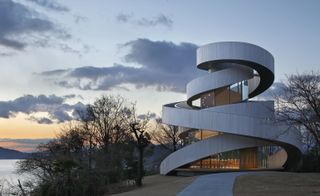
Best Chapel
Ribbon Chapel, Onomichi, Japan, by Hiroshi Nakamura
Hiroshi Nakamura understands the contribution architecture can make to truly memorable nuptials. His latest project, the striking, upward-swirling form that is the Ribbon Chapel in Onomichi, Hiroshima Prefecture, is a wedding venue located halfway up a hill in the lush garden of a resort hotel. With two mutually supporting, spiralling staircases that come together at the top, Nakamura's architectural concept nods to the joining of two individual paths into one. A thread running through the entire project is the traditional Japanese notion of akai ito, or 'red string', that invisibly links two soulmates. Unlike a traditional building, this chapel's 'ribbons' twist and turn to become its roof and eaves, walls and floors. The bride and groom each walk up their own separate staircase, so that they remain hidden from each other until they meet at the top, while guests observe this part of the occasion from the garden below. While the architect's design is the perfect setting for a wedding ceremony, he didn't intend the chapel to serve only that purpose. It can also be used for concerts and private parties, or even turned into a restaurant, says Nakamura. 'It's a simple building composed of paths, along which sceneries of ocean, mountain, sky and distant islands successively appear and disappear.' It certainly marries form with fantasy.
Writer: Cathelijne Nuijsink
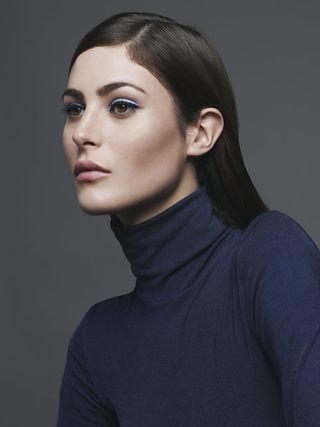
Best Face Fixers
Our make-up of the year
Besides seasonal colour trends, fashions in beauty move slowly. Not changing fast this year is a tendency towards complexions that show natural radiance, brows that are strong and lips that are natural or matt. But we've also fallen for the stand- out colour trend of the year. Blue, from royal to aqua, smudged, winged or flashed in a bright line across the top of the eyelid, is back after a 30-year hiatus, and it's looking fresh. Here are the best tools to achieve the year's fashionable face.
Complexion: Mine de Rien, €160, by Serge Lutens. Brows: The Perfect Brow kit, £75, by Chantecaille. Lips: Audacious Lipstick in Barbara, £24, by Nars. Eyes: Chromagraphic pencil in Hi-Def Cyan, £14, by MAC. Top, £119, by Wolford
Fashion: Zoë Sinclair; Writer: Emma Moore

Best Optical Illusion
Trompe-l'œil comes up trumps
Occasionally, furniture design veers away from solid certainty and adopts a more illusive bent. Flitting between illusion and confusion, design duo Raw-Edges devised a series of rugs that can appear either vivid or calm, depending on the viewer's orientation. Equally playful is Éric Chevallier's collection of apparently 'floating' seats, each one identified by a different shade of green and angle of inclination. Nodding to nature's optical artfulness, meanwhile, Jean-Baptiste Fastrez was inspired by the iridescent shell of a beetle to create his eye-boggling vase.
Pictured: ‘Degré’ chairs, from €1,500, by Éric Chevallier, for Domeau & Pérès. ‘Scarabée’ vase, €370, by Jean-Baptiste Fastrez, for Moustache. ‘Lake’ carpet, from €8,200, by Raw-Edges, for Golran
Interiors: Anne Chaniolleau; Writer: Rosa Bertoli

Best Rebrand
Loewe, by Jonathan Anderson and M/M (Paris)
As part of its ongoing reinvention, Spanish luxury brand Loewe recently unveiled a fresh identity developed by creative director Jonathan Anderson and graphics duo M/M (Paris). 'Past, Present and Future' is the mantra guiding the house's creative renaissance, and the new look nods to both its heritage and its contemporary vision. The original logotype has been redesigned in a typeface inspired by the work of German-born typographer and calligrapher Berthold Wolpe, while the brand's motif (informally known as el cangrejo, or 'the crab'), designed in 1970 by artist Vicente Vela, was reimagined following a study of traditional cattle-branding practices. Redrawn with characteristic M/M (Paris) finesse, the new, streamlined monogram is a faithful adaptation of Vela's work, all done with a light touch.
Pictured: Contrasting with a 1940s logo (top right), loewe’s latest identity includes a redrawn ‘Crab’ motif (centre) and logo (bottom). The motif is seen here embossed on a large pouch, £425, and coin purses, £150 each
Writer: Rosa Bertoli
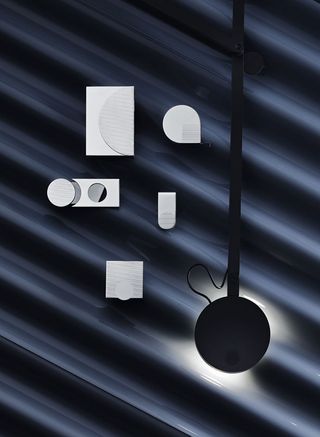
Best Office Accessories
Small wonders and a bright idea
Hermès-owned silversmith Puiforcat has never been short of smart ideas, but we're especially tempted by its Argent de Poche collection of sterling-silver, pocket-sized products. Designed by Pauline Deltour, it riffs on the interplay between circles and squares, between grooved and mirror-polished surfaces,in a contemporary take on the art deco aesthetic of the company's founder Jean Puiforcat. Equally pared down, but in an entirely different mode, Jean Nouvel's 'Equilibrist' lamp for Artemide is his interpretation of a 'high-tech traffic light'. Two lights - one square, the other circular - rotate around a vertical axis. The perfect desktop distraction.
Pictured clockwise from top left, ‘Card holder’, €900; ‘Tape measure’, €600; ‘Money clip’, €280; ‘Cigarette box’, €1,350; ‘Cigar cutter’, €450, all by Pauline Deltour, for PuIforcat. Detail of an ‘Equilibrist’ lamp, price on request, by Jean Nouvel, for Artemide
Interiors: MarIa Sobrino; Writer: Christopher Stocks
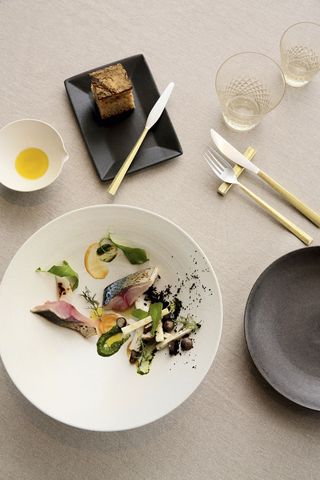
Best Food
01. La Bonne Table, Tokyo
Chef Shinobu Namae, of Tokyo's L'Effervescence, has created another must-try eatery in the city, La Bonne Table. While the basic premise is informal French (Namae has worked with Michel Bras), Namae's fondness for New Nordic cuisine is seen in his use of local produce and the Scandinavian-inspired interior. Vegetables, from Etsuo Asano's farm in Chiba, are given deserved attention, while Namae's stint as The Fat Duck's pastry chef ensures a rewarding finale.
Pictured: Shinobu Namae won Wallpaper* over with this plate of lightly grilled mackerel with Saikyo miso-and-sorrel sauce, served with black olive ‘earth’, turnip and propagules of Japanese mountain yam.
Writer: Jens H Jensen
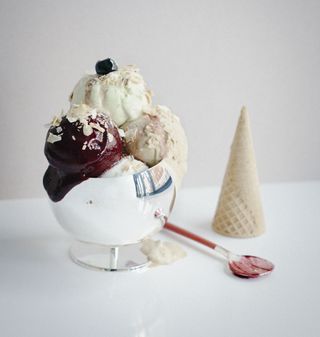
Best Food
02. Morgenstern's, New York
Just as we were starting to feel jaded by the notion of gourmet ice cream, New York parlour Morgenstern's, opened last year by chef Nick Morgenstern, had our taste buds tingling all over again. What sets it apart is its succinct yet adventurous menu. Classic vanillas, chocolates and coffees (several varieties of each) jostle with experimental favours like salt and pepper pine nut, and banana curry, and there's an array of sundaes and collaborative limited-edition favours to boot.
Pictured: We made our own Morgenstern’s sundae with, clockwise from left, blackcurrant sorbet, green tea pistachio ice cream, coffee crisp ice cream, burnt honey vanilla ice cream, topped wIth luxardo cherries and toasted coconut.
Writer: Pei-Ru Keh
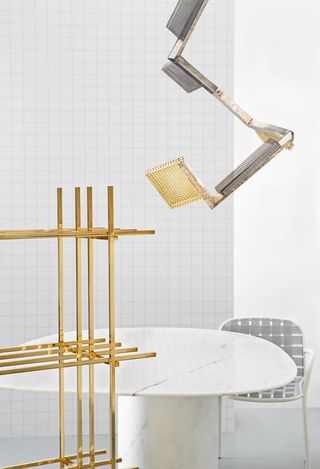
Best Grid
A fine line-up of geometric pieces
Wallpaper* is particularly alert to displays of geometric rigour. So we were drawn to Minimalux's first foray into furnishings, which includes this precisely composed bookshelf made of 33 interlocking metal bars. Milanese architect Vincenzo De Cotiis took the graphic theme a step further with his 'DC1406' lamp, which at first glance may seem like a random composition, but on closer inspection reveals a meticulous geometry of gridded metal panels. Scholten & Baijings' table collection saw the duo's signature graphic patterns subtly engraved on Carrara marble. Meanwhile, Stefan Diez's chair for Emu and Claesson Koivisto Rune's wallpaper offer a classic interpretation of the geometric theme in 3D and 2D respectively.
From left to right, ‘Hash’ bookshelf, £6,850, by Minimalux, from Mint. ‘Solid Patterns’ table, price on request, by Scholten & Baijings, for Luce di Carrara, from Spazio Rossana Orlandi. ‘DC1406A’ brass chandelier, price on request, by Vincenzo de Cotiis. ‘Yard’ armchair, €320, by Stefan Diez, for Emu. ‘Blur’ Wallpaper, £55 per 10m roll, By Claesson Koivisto Rune, for Engblad & Co
Interiors: Maria Sobrino; Writer: Rosa Bertoli
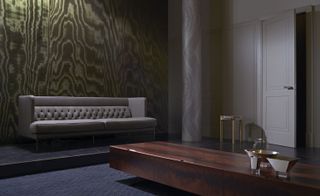
Best Neoclassical
This year's new classics are keepers that combine rigour, lightness and timeless good looks
Piero Lissoni’s sofa is a well-executed combination of clean lines and traditional shapes. Its wide seat and classic details make it a masterpiece of design and comfort. This collection of wooden panelling and panelled doors by Robert AM Stern Architects for Italian brand Lualdi features unconventional proportions. Meanwhile, Belgian designer Michaël Verheyden’s elegant side table consists of bronze legs and a locally sourced marble top; its size and height can be customised. A low cabinet by Antonio Citterio is an exercise in discretion. The mahogany piece is balanced on aluminium legs and conceals three wide drawers within.
Pictured: ‘Amoir Libre 009’ fabric, £111 per m, by Dedar. ‘Lipp’ sofa, £7,479, by Piero Lissoni, for Living Divani, from Coexistence. ‘QuaDro’ rug, $10,075, by Ben Soleimani, for Restoration Hardware. ‘Piuma’ TV cabinet, £9,759, by Antonio Citterio, for Flexform, from Harrods. ‘Tube’ side table, £7,850, by Michaël Verheyden, from Willer. ‘Avenue’ door with ‘Avenue Boiserie’ panelling, price on request, by Robert AM stern, for Lualdi. On cabinet, ‘Model 7’, £1,585; ‘Model 8’, £3,170; ‘Model 5’, £2,025, all Part of the Santambrogia collection, by Andrea Branzi, for De Vecchi Milano 1935. ‘Anguilla’ wallcovering, £325 per roll, by zinc textile
Interiors: Matthew Morris; Writer: Rosa Bertoli
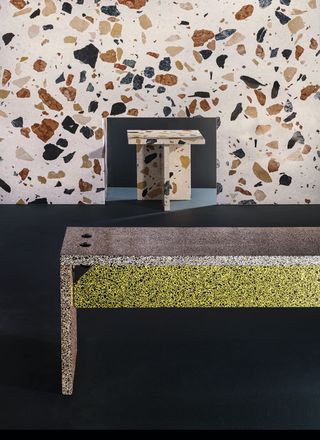
Best Reuse
We champion those playing the regeneration game
Sustainability is now a key driver of material innovation. And that's a good thing. So we're very taken with 'Marmoreal', an engineered multicoloured marble devised by designer Max Lamb for Dzek. The marble is built to be suitable for flooring and wall covering, but can also be used to construct furniture. Similarly, Swiss design duo Stéphane Halmaï-Voisard and Philippe-Albert Lefebvre, aka Terrazzo Project, have just released 'TP-Panels', taking cues from Italian terrazzo floors. Although aesthetically faithful to the original, their panels are made of resin, cement and stone cast onto corrugated aluminium sheets and, in a significant update of a classic, they are stain-proof, UV stable and suitable for both indoor and outdoor use.
Pictured: ‘Marmoreal’ side table, from £1,800, by Max Lamb, for Dzek. ‘TP-Panels’ bench, £2,440, by Terrazzo Project
Interiors: Matthew Morris; Writer: Rosa Bertoli
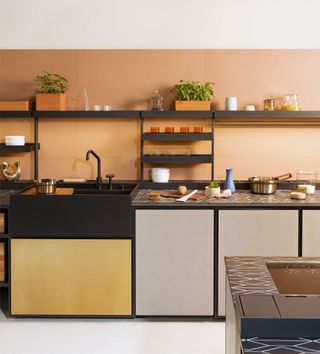
Best Kitchen
'Salinas' kitchen, by Patricia Urquiola, for Boffi
For 'Salinas', her first kitchen, Spanish designer Patricia Urquiola went back to her roots. 'Salinas is the beach of my childhood,' she says. 'A long sandy beach along the Bay of Biscay, with huge crashing waves and intense colours. The kitchen in my grandfather's house, which commanded a view of that beach, brings back fond memories.' A mix-and-match system with a tubular metal structure, 'Salinas' can be assembled in single materials or colours, or in any combination of the materials and colours available for each element. Dekton, ceramic and decorated lava stone are among the worktop selection, while door choices include PaperStone (made from 100 per cent recyclable material), wood and concrete.
Pictured: ‘Salinas’ kitchen, price on request, shown with doors in PaperStone (left) and metal (below sink), worktops in Nerosicilia (glazed lava stone), and sink in absolute black quartzite
Interiors: Maria Sobrino; Writer: Christopher Stocks

Best Home Office
Treetop studio, South Australia, by Max Pritchard
We are less than an hour out of Adelaide, where the foothills that ring the city meet the coast and the suburban streets come to an abrupt end as they hit a wall of dark, glacial rock. At this intersection, on a site overlooking the vast Gulf St Vincent, stand the home and new studio of Max Pritchard, one of Australia's most interesting architects. Some 25 years separate the completion of the house, a linear steel-framed glass box perched on steel pilotis, and the studio, a timber construction that stands amid blue gums and acacias. The studio's structure is simple yet sculptural: cylindrical, 6m tall, 4m in diameter, and topped with a roof that shades the workspace from the sun during the hottest parts of the day. Ground level is a storage area. Above is a studio lined with bookshelves and fitted with breezy windows that offer views of the sea. The building brings together three key elements of Pritchard's work: sculptural fair, affordability and expressed structure. 'The radiating battens on the ceiling reflect the building. You're seeing the whole structure,' he says. 'I like circles, the pure form,' he adds. 'It suits the function of a simple, contained office. But then a lot of sweat went into it, so I might be biased.' Biased maybe, but it does work. And the pleasing news is, Pritchard is using his new studio. 'I've done a few designs there - good ones,' he says.
Writer: Gordon Knight

Best Film Set
By Jensen & Skodvin Architects and Mark Digby, as seen in Ex Machina, directed by Alex Garland
In Ex Machina, the fabulous new artificial intelligence (AI) flick from director Alex Garland, the author and screenwriter behind films such as Sunshine and 28 Days Later, thresholds are crossed courtesy of electronic keycards, and internet billionaires have acquired impeccable taste in art, architecture and interior design. The film, almost in its entirety, plays out inside a spectacular cliff-side home with a facade of glass and timber, a precise, modernist intrusion of the man-made into nature, somewhere in the wilderness of Alaska. The house belongs to Nathan (played by Oscar Isaac), the billionaire CEO of 'the world's biggest internet company', who likes vodka, Jackson Pollock, tinkering with AI, and sushi made by Kyoko (Sonoya Mizuno), his seductive Japanese housekeeper. In reality, the house is not a single residence, but a cinematic synthesis of a set built at Pinewood Studios, near London, the Juvet Landscape Hotel and a privately owned summer house, both located not in Alaska but in north-western Norway, and designed by Oslo-based Jensen & Skodvin Architects. Inside the house, an enormous slate-grey boulder juts into a living room that has been built around it, jagged panes of glass disappearing into its surface, separating the exterior from the interior. Upstairs, endless windows offer exquisite views onto the surrounding woodlands, creating an expansive space. In contrast, a concrete-heavy subterranean level reveals one low-lit, isolated room after the next. The interiors throughout the house are muted if not somewhat anonymous, revealing a version of tomorrow that is foreboding, but stylish. Ex-Machina is released on 23 January in the UK.
Writer: Natalia Rachlin
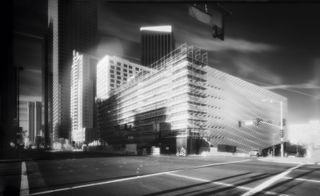
Best Building Sites
01. The Broad, Los Angeles, by Diller Scofidio + Renfro
Los Angeles philanthropist Eli Broad has a habit of putting his name on the many cultural buildings he commissions. Recent examples include the Broad Contemporary Art Museum at LACMA and the Broad Stage in Santa Monica. But one building is so close to this art-collecting billionaire's heart that he is simply calling it The Broad. Designed by acclaimed New York architects Diller Scofidio + Renfro (DS+R), the 120,000 sq ft, $140m museum also happens to be one of LA's most anticipated new buildings. Set to contain almost 2,000 contemporary art works from Broad's collection, construction is now in its final stages, with an opening scheduled for this autumn. The Broad appears dizzyingly complex, with its intricate façade, but it is based on a simple construct. The Vault is the heart of the museum and contains art storage and conservation facilities, while the Veil is a three-dimensional structure made up of hundreds of honeycomb-shaped openings that cover the roof and flow over the glass façade, touching down on the pavements. Every other element of the museum (with the exception of an adjacent 24,000 sq ft public plaza) stems from those two starting points. The lobby, which opens to Grand Avenue via two exposed corners behind the Veil, appears almost cave-like, shaped around the underside of the Vault, with curves meant to create a sharp contrast to the highly angular exterior. Wandering around the lobby, glimpses can be caught through the tunnelled escalator into the pièce de résistance, the building's 35,000 sq ft third floor galleries, which feature 23ft tall ceilings and no columns. The roof is instead held up by five 190ft-long steel girders, which are invisible from the viewer's perspective. And thanks to hundreds of angled skylights, the space changes its mood dramatically as daylight transitions.
Pictured: a view of The Broad, still covered in scaffolding, at the junction of Grand Avenue and Second in Downtown Los Angeles.
Writer: Sam Lubell

Best Building Sites
02. Pavilion Zero, Expo Milano 2015, by Michele De Lucchi
Stretched over a million square metres, the building sites for Expo Milano 2015 deserve accolades, at the very least, for their mammoth dimensions. From May, the Expo will host more than 140 countries for a six month period, during which a frenzy of activity will centre on the theme of 'Feeding the Planet, Energy for Life'. Among the national pavilions, there will also be thematic areas dedicated to core Expo issues, including Pavilion Zero, by architect Michele De Lucchi, which is set to make a striking impact at the fair entrance. It appears now as a maze of steel bars, but will eventually be covered in stepped strips of fIr and oak. The concept centres around the idea of a 'crust', naturally-forming layers on everything from a flaky cake to the slow build-up of the earth's strata. Explaining his valley of crispy-skinned, cave-like dwellings, De Lucchi says, 'I was enchanted by this idea of the inner earth. We're constantly looking at our trees, mountains and skies, but rarely think about what's underfoot.' When the Expo closes in October, Pavilion Zero will be dismantled and recycled, a fate that does not worry the architect. 'The great message of this Expo is that the world needs to be adjusted to our future,' he says. 'We can't continue to fill the world up. I'm happy to give a good example of designing something that will go back to nature.'
Writer: JJ Martin

Best Building Sites
03. Taipei Performing Arts Center, Taipei, by OMA
For as long as anyone can remember, the north Taipei neighbourhood of Shilin has been renowned for its lively, crowded night market, hawking everything from household goods and knick-knacks to steaming soupy noodles, sweets and fragrant corn-on-the-cob. But since the Taipei City Government has been planning to add a unique performing arts centre in the midst of this dynamic neighbourhood. The night market was moved to temporary location a block away, and an international competition for the new Taipei Performing Arts Center was held for the site. Rotterdam-based heavyweight OMA, led by Rem Koolhaas, won the bid with an ambitious but compact design of three auditoria grafted onto a giant cube clad in corrugated glass.Unusually but necessary given the location the centre in a dense urban plot, instead of a public front entrance and a back-of-house, the three theatres plug into the central cube, which consolidates the stages, backstage areas and support spaces into a single and efficient whole. The centre is schedule to open at the end of 2015.
Writer: Daven Wu
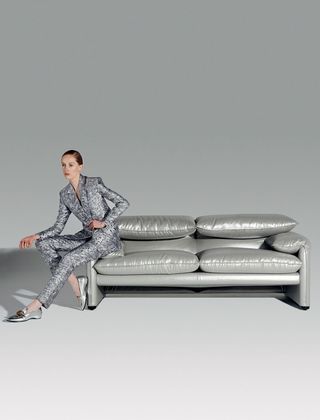
Best Reissues
01. 'Maralunga' sofa, by Vico Magistretti, for Cassina
When Vico Magistretti designed the 'Maralunga' sofa for Cassina in 1973, his inspiration was the home itself. He imagined a warm, domestic environment and a seat that could adapt to any family's needs. Now, this classic model has been updated to ft with a modern, futuristic idea of home. Titled 'Mercurio Vivo', and available in a limited edition of 40, it is upholstered in a silver fabric that enhances the original padded shape and its famous adjustable back.
Pictured: Jacket, £2,592; trousers, £1,053, both by Mary Katrantzou. Shoes, £430, by Tod’s. 'Maralunga Mercurio Vivo' sofa, £5,466, by Vico Magistretti, for Cassina
Interiors: Anne Chaniolleau; Writer: Rosa Bertoli
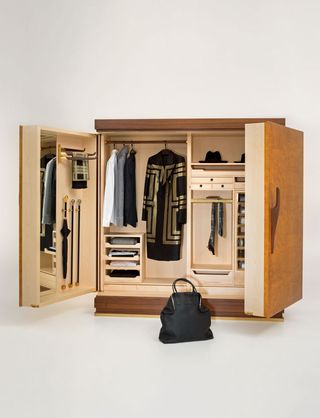
Best Reissues
02. 'Gentleman' wardrobe, by Guglielmo Ulrich, for Ceccotti Collezioni
Living in a box might have more appeal if your box was as alluring as the 'Gentleman' wardrobe. Based on a 1930s design by Guglielmo Ulrich and handmade in a limited edition of ten, it combines fine woods (rosewood frame and handles, myrtle burr doors, maple drawers, macassar ebony knobs) with brass accessories. A dandy's delight, it has clips for canes, trays for ties, a laundry cabinet and a place for perfumes. It also comes with a full-length mirror and internal light so you can admire yourself.
Pictured: 'Gentleman' wardrobe, price on request, by Guglielmo Ulrich, for Ceccotti Collezioni. We’ve stocked our ‘Gentleman’ wardrobe with items by Alexander McQueen A/W14. Hats, from a selection, by Lock & Co
Interiors: Maria Sobrino; Writer: Christopher Stocks
Rosa Bertoli was born in Udine, Italy, and now lives in London. Since 2014, she has been the Design Editor of Wallpaper*, where she oversees design content for the print and online editions, as well as special editorial projects. Through her role at Wallpaper*, she has written extensively about all areas of design. Rosa has been speaker and moderator for various design talks and conferences including London Craft Week, Maison & Objet, The Italian Cultural Institute (London), Clippings, Zaha Hadid Design, Kartell and Frieze Art Fair. Rosa has been on judging panels for the Chart Architecture Award, the Dutch Design Awards and the DesignGuild Marks. She has written for numerous English and Italian language publications, and worked as a content and communication consultant for fashion and design brands.
-
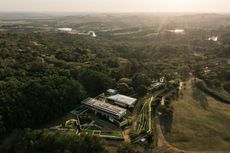 The Brazilian Forest House injects art into a modernist-inspired, contemporary design
The Brazilian Forest House injects art into a modernist-inspired, contemporary designThe Brazilian Forest House, designed in upstate São Paulo by FGMF, brings together nature and art
By Ellie Stathaki Published
-
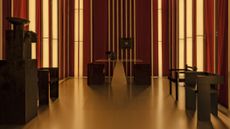 Waiting room inspo: Inside Studioutte’s cinematic Sala D’Attesa at Milan Design Week
Waiting room inspo: Inside Studioutte’s cinematic Sala D’Attesa at Milan Design WeekStudioutte’s Sala D’Attesa, staged in Nolo during Milan Design Week 2024, was a scenographic interior merging different design sensibilities
By Laura May Todd Published
-
 Bang & Olufsen’s Recreated Classics series continues with a CD player revival
Bang & Olufsen’s Recreated Classics series continues with a CD player revivalBang & Olufsen’s Beosystem 9000c music system brings the original digital compact disc format back to life and pairs it with the latest in speaker design
By Jonathan Bell Published